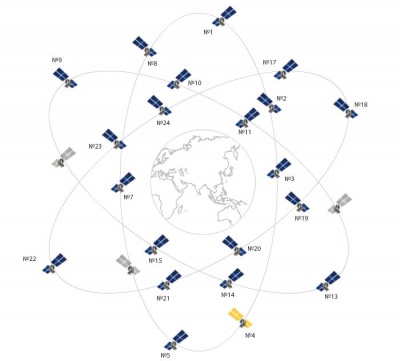If you wish to contribute or participate in the discussions about articles you are invited to contact the Editor
GLONASS Space Segment
| GLONASS | |
|---|---|
| Title | GLONASS Space Segment |
| Author(s) | GMV |
| Level | Basic |
| Year of Publication | 2011 |
The main functions of the Space Segment are to transmit radio-navigation signals, and to store and retransmit the navigation message sent by the Control Segment. These transmissions are controlled by highly stable atomic clocks on board the satellites.[1]
The space segment is defined by the number of satellites in the constellation (to ensure visibility of, at least, 4 satellites in view at any time and from anywhere on Earth), as well as the characteristics of the satellites in question.
GLONASS Satellite Constellation
The GLONASS space segment consists nominally of 24 operational satellites, distributed over three orbital planes.[2] At the time of editing this article (June 2011), the number of satellites in the constellation is 27, 23 operational, one in commissioning phase and three in maintenance.[3]
The longitude of ascending node differs by 120 deg from plane to plane. There are eight satellites per plane, separeted 45 deg in argument of latitude. The difference in the argument of latitude of satellites in equivalent slots in two different orbital planes is 15 deg. Each satellite is identified by its slot number, which defines the orbital plane and its location within the plane.[4]
The GPS space segment also consists of nominally 24 satellites, which are, however, distributed over six orbital planes, differing from plane to plane by 60 deg in longitude of the ascending node.
GLONASS satellites operate in circular orbits at an altitude of 19100-km, an inclination of 64.8 deg and each satellite completes the orbit in approximately 11 hours 15 minutes. This means that for a stationary observer the same satellite is visible at the same point in the sky every eight sidereal days. Since there are eight satellites in each orbital plane, satellite positions in the sky get repeated each (although by different satellites). With the 11 h 58 min orbital period for GPS satellites, the same GPS satellite is visible at the same point in the sky every (sidereal) day.
Satellites carry atomic clocks and the payload needed for handling (receiving, processing and transmitting) navigation data. They also have reflectors to allow laser ranging from dedicated ground stations.
Differences between GPS and GLONASS constellations are summarized in the following table:[5]
| GLONASS | GPS | GALILEO | |
|---|---|---|---|
| Number of satellites | 24 | 30 | 30 |
| Number of orbital planes | 3 | 6 | 3 |
| Orbital Inclination | 64°8' | 55° | 56° |
| Orbital altitude | 19.140 km | 20.180 km | 23.222 km |
| Period of revolution | 11h 15m | 11h 58m | 14h 22m |
| Launch site | Baikonur/Plesetsk | Cape Canaveral | Kourou (French Guiana) |
| Date of first launch | 02/10/82 | 22/02/78 | N/A |
| Satellites for launch | 1/3 | 1 | 2 |
| Datum | PZ-90.02 | WGS-84 | GTRF |
GLONASS Satellite Description
GLONASS satellites are divided into blocks. Each block is a set of satellites usually launched within certain time interval. Below there is a brief description of the different blocks:[1]
- Prototypes (Generation zero).The first prototypes of GLONASS (Uragan) satellites were sent into orbit in October 1982, being up to 18 spacecrafts launched between 1982 and 1985.These first GLONASS satellites are referred to as Block I vehicles and, although being designed to last only one year, many of them had an actual lifetime up to more than 14 months.
- First generation. The first true GLONASS satellites were launched between 1985 and 1990. They are divided into different block vehicles (Block IIa, IIb, and IIv), being the design lifetimes the main difference between blocks. The lifetimes ranged from the 2-year design of Block IIb to 3-year of Block IIv, with many spacecraft exceeding this (up to 4.5 years).These satellites are all 3-Axis stabilized spacecrafts with satellite mass of about 1 250 Kg, being equipped with a basic propulsion system to allow relocation within the constellation. They have improved time and frequency standards over the previous spacecraft prototypes, with increased frequency stability.
- Second generation, GLONASS-M (or Uragan-M) is the second generation of satellites, where -M indicates modernized or modified. They were developed from 1990 on, with the first one sent into orbit in 2003, and a total of twenty satellites launched up to March 2010. GLONASS-M satellites have a longer design lifetime of seven years as a result of propulsion system and clock stability (Cesium clocks) improvements. This is a big lifetime increase compared with the 2-3 years of previous first generation spacecraft, but it is still under the 10 years mean life of the GPS. These satellites have a mass of around 1 480 kg. Their size is of 2.4 m of diameter and 3.7 m in high, with dual solar arrays of 7.2 m. They also carry corner-cube laser reflectors for precise orbit determination and geodetic research. A remarkable feature of these satellites is the addition of a second civil signal on G2 band, which allows the civil users to cancel out the ionospheric refraction.
- Third generation: The following generation of satellites, GLONASS-K, has a service life of 10 years and a reduced weight of only 750Kg (allowing their launch in pairs from Plesetsk Cosmodrome on Soyuz-2-1a). This new generation of satellites includes, for the first time, code-division-multiple-access (CDMA) signals accompanying the legacy frequency-division-multiple-access signals. There will be two versions:
- GLONASS-K1 will transmit a CDMA signal located in the L3 band. The first GLONASS-K1 satellite was successfully launched on February 26 2011 [6] and the new L3 CDMA signal is already being tracked by several receiver companies.[7]
- GLONASS-K2 to be launched in 2013, will relocate the L3 signal to 1207.14 MHz and add an additional open CDMA signal located at 1575.42 MHz in the L1 band.
A modernized GLONASS-K satellite, GLONASS-KM, for launch after 2015 [8] may also transmit on the GPS L5 frequency at 1179.45 MHz. An alternative to the present three-plane, equally spaced satellite constellation, is also under consideration.
Finally, the following table gathers the main characteristics of the different GLONASS satellite blocks:[5]
| Glonass | Glonass-M | Glonass-K | |
|---|---|---|---|
| Status | out of service | in service | in service |
| First launch | 1982 | 2003 | 2011 |
| Lifetime (years) | 3 | 7 | 10 |
| Mass (Kg) | 1250 | 1480 | 750 |
| Output power (W) | 1000 | 1600 | 1600 |
| Number of civil signals | 1 | 2 | 2 |
| On board clocks stability | 5x10-13 | 1x10-13 | 1x10-14 |
Notes
References
- ^ a b J. Sanz Subirana, JM. Juan Zornoza and M. Hernández-Pajares, Global Navigation Satellite Systems: Volume I: Fundamentals and Algorithms
- ^ Russian system of differentional correction and monitoring
- ^ GLONASS constellation status
- ^ GLONASS SCC Information
- ^ a b GLONASS System Description in glonass.it web site
- ^ Russia’s First GLONASS-K In Orbit, CDMA Signals Coming, InsideGNSS
- ^ First GLONASS CDMA Signal on L3Tracked
- ^ GLONASS Update Delves into Constellation Details, GPSworld


